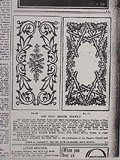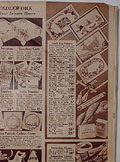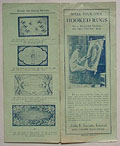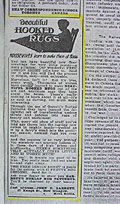|
|
| |
 |
|
| |
 Merchant's
promotional sign Merchant's
promotional sign
|
|
| |
|
|
|
Garrett's "Bluenose" Hooked Rugs
by Scott
Robson
Throughout the first half of the 1900s, hooked mats on
floors
across Canada carried the name "Bluenose," a well-known Nova Scotian name.
Some
even carried an image of the famous fishing schooner of the same name.
About
1926, the Garrett family business in Pictou County, Nova Scotia, adopted
the
word as its trade name for hooked mat patterns. Its printed burlap
patterns,
distributed by mail order, transported the name and the company's designs
into
homes far away. Although Garrett's was neither the first nor the only
producer
of hooking patterns in Nova Scotia, the company was certainly the largest,
and
by far the longest in operation.
The Garrett Business | John Garrett's First Patterns
| Garrett Designs and Distribution
|
The Garrett Business
| |
 |
|
| |
 One
of John E. Garrett's earliest printed patterns for hooking. One
of John E. Garrett's earliest printed patterns for hooking.
|
|
| |
|
|
|
In 1892, John E. Garrett (1865-1937) of New Glasgow, Nova Scotia,
printed
and sold his first "patterns" for hooking. These printed designs on burlap
would
become the base or foundation cloth for hooked mats, or rugs.
(In Nova Scotia today, many hookers still maintained the local usage of
the
word "mat," while people from other places say "rug." Garrett used "rug"
in most
cases, probably taking into consideration his American market, but he also
advertised
"door mats" and even used both together at times, as in "hooked rugs and
mats.")
Although John started working in his father's upholstery and furniture
business,
he preferred to use his artistic talent to design mats. His small
enterprise
began in two rooms at home and grew into a company that served customers
across
Canada, as well as in Britain, the United States and elsewhere, including
South
Africa, New Zealand, Hawaii.
| |
 |
|
| |
 Hooked
rug on a Garrett pattern introduced about 1901,134.6 x 222.3 cm. Hooked
rug on a Garrett pattern introduced about 1901,134.6 x 222.3 cm.
|
|
| |
|
|
|
| |
 |
|
| |
 Garrett's
ad in the Family Herald & Weekly Star, January 31, 1900 Garrett's
ad in the Family Herald & Weekly Star, January 31, 1900
|
|
| |
|
|
|
In the first year, about 1800 patterns were sold; in the third year,
over
6000. Efficient and economical production was required, so John developed
his
own simple printing method. In 1892, his first year of operation, he
obtained
a Canadian patent for his process of stamping designs on burlap.
| |
 |
|
| |
 Garrett
patterns and hooking materials in Simpson's Spring/Summer Catalogue,
1941, p. 181 Garrett
patterns and hooking materials in Simpson's Spring/Summer Catalogue,
1941, p. 181
|
|
| |
|
|
|
As production improved, output rose, and demand increased, John Garrett
expanded
distribution by mail order, with his own pattern design sheets and, later,
catalogues.
As early as 1900, he placed advertisements in various farm papers, but he
found
that the most successful vehicle was the popular Family Herald &
Weekly Star,
published in Montréal. The business expanded to the extent that, by
the
onset of the First World War, over 200 000 yards of burlap were used
annually.
| |
 |
|
| |
 Garrett's
hooking machine with box, patented 1926. Garrett's
hooking machine with box, patented 1926.
|
|
| |
|
|
|
Commercial activities of the Garrett business included the sale of wool
yarn,
hooks, binding, frames, and other materials, as well as several versions
of a
rug-hooking machine. Garrett began experimenting with various models and
refinements
of the machine, one called "Garrett's Rug Hooker" (advertised in 1920) and
another
named "Little Wonder." Finally, in 1926, he patented the Bluenose Rug
Hooking
Machine in Canada, the United States, and Great Britain. It was popular
immediately,
with about 12 000 selling in the first year. The machine was meant to be
used
with yarn, but could be used with finely cut rags.
| |
 |
|
| |
 Garrett's
catalogue, 1930-31. The hooker is using a Bluenose hooking machine and
frame. Garrett's
catalogue, 1930-31. The hooker is using a Bluenose hooking machine and
frame.
|
|
| |
|
|
|
Three of John's children were employed in the business. Frank
(1892-1958)
and Cecil (1902-1954) worked at the main factory in New Glasgow.
Arthur
(1888-1954) managed the branch factory at Malden, Massachusetts. The
branch
had opened in 1929, but the company had operated an outlet in the Boston
area
from about 1902, at various addresses; Arthur's wife, Katherine, continued
to
run that location after Arthur's death. Frank's son, Cameron, took over
the New
Glasgow location after his father's death in 1958.
| |
 |
|
| |
 Garrett's
catalogue, 1940. Garrett's
catalogue, 1940.
|
|
| |
|
|
|
Printed rug patterns declined through the 1960s and 1970s, then ceased;
the
remaining stock was sold into the 1980s. In 1985, Ed MacArthur, who had
worked
as general manager, bought the business. He later sold the rug stencils to
someone
who wanted to print the patterns for sale.
|
John Garrett's First Patterns
| |
 |
|
| |
 Lithographic
bird's-eye view of Halifax, 1879 (detail). Lithographic
bird's-eye view of Halifax, 1879 (detail).
|
|
| |
|
|
|
At a time when business was booming, Cecil Garrett described his
father's
start in the rug hooking industry in a talk given in October 1927.
According
to Cecil, it all began in 1879 when John Garrett saw rug patterns on
burlap in
a store window in Halifax as he walked to work:
"The owner of that store made an assignment. The stock was bought by an
auctioneer
firm, Shand, Ferguson & Clay ... They were afraid the Rug Patterns
would
not sell, and they marked them down, with the result that they were about
the
first things that did sell. Mr Ferguson, who was more or less of an
artist, made
some patterns, and they sold. Later on this man Ferguson moved to New
Glasgow,
and opened a store next door to my grandfather's furniture store ... He
still
continued to make Mat or Rug patterns for his retail trade, and any
surplus stock
he shipped to Halifax. These patterns were all made with stencils.
"On one occasion, Mr Ferguson commissioned my Father, who was then only
eighteen,
when on a trip to Boston, to get him a few patterns there from which to
get ideas,
and coming home on the boat, it occurred to my Father that these patterns
should
be printed. So, when he arrived home, he jig-sawed a scroll out of
basswood,
rolled an ink roller over it, and placing a piece of burlap on that,
rolled it
with a metal roller for a weight, and it was a success, and we have been
making
Rug Patterns ever since!
"The first season's sales of Patterns were
only
one hundred and fifty dozen [1800], the second, three hundred and fifty
dozen
[4200], third, five hundred and eight dozen [6096]. Last season was eleven
thousand
dozen [132 000]. For the past three years our order for burlap has been
150,000
yards [137 000 km] each year."
|
Garrett Designs and Distribution
| |
 |
|
| |
 Garrett's
ad in The United Farmer's Guide (Gardenville, Quebec), November 15,1921,
p. 23. "The free design sheet is yours for the asking, with 67 pretty
rug designs." Garrett's
ad in The United Farmer's Guide (Gardenville, Quebec), November 15,1921,
p. 23. "The free design sheet is yours for the asking, with 67 pretty
rug designs."
|
|
| |
|
|
|
In more than 80 years, the firm printed burlap patterns with hundreds
of
designs, many drawn by John and then by his son Frank, who had trained as
a commercial
artist. These designs can be traced through the pattern sheets and
catalogues,
which were often issued yearly. An advertisement in the Family Herald
&
Weekly Star on February 28, 1900, boasted "over sixty designs for mat
hookers"
in six sizes. In 1925, there were "more than a hundred designs." Some were
inspired
by older mats and some were adapted from patterns bought in Boston; a few
have
been identified as versions of Edward Frost's designs, which are well
known in
New England. However, most of the designs were created by Frank Garrett
and his
father.
| |
 |
|
| |
 Garrett's
pattern sheet for 1923-24 Garrett's
pattern sheet for 1923-24
|
|
| |
|
|
|
|
Soon after 1900, Eaton's department store began to market Garrett
patterns
across Canada. The Hudson's Bay Company, Simpson's, and others followed.
From
the 1920s to the 1940s, Eaton's was Garrett's best customer for the mat
patterns.
In the winter of 1926-27, Eaton's sold over 900 dozen (10 800) of
two designs
alone.
| |
 |
|
Printed sheet promoting a
pattern designed by Frank Garrett for the royal visit to Canada in May
and June 1939. The state crowns of the king and queen are bordered with
shamrock, thistle, and rose, symbols for Great Britain, and a maple leaf
for Canada.
|
 |
|
|
| |
| |
 |
|
"The Three Bears," a Garrett
printed pattern, 74 x 113.5 cm. According to Cameron Garrett: "Along
with the schooner Bluenose, The Three Bears was our all-time best-seller."
(Canadian
Living, September 5, 1987). Both patterns had been introduced in the
1932 catalogue and remained popular in Canadian and American markets.
|
 |
|
|
| |
| |
 |
|
Garrett patterns and hooker
as seen in Simpson's Fall/Winter Catalogue, 1935-36, p. 155
(detail).
|
 |
|
|
The patterns were stamped on jute burlap, then hand-coloured, to
suggest placement
of colours and to brighten the rather drab effect of black ink on jute
cloth.
As Garrett's pattern sheet for 1921 said: "Our Rug Patterns are stamped on
a
special make strong burlap which we have manufactured expressly for Rug
Patterns.
Flowers and leaves, etc. are all in natural colors; maple leaves are in
autumn
colors and scrolls are generally dark and light brown. It is not necessary
for
you to use these colors. You should be governed by your own taste and also
the
Rags which you have at hand."
In addition to designing and printing patterns for hooking, the firm
operated
a print shop for a number of years (it was sold around 1923), where it
likely
produced its own pattern sheets and catalogues. The business was described
in
1916: "The only factory in Canada for the manufacture of Burlap Rug
patterns
for home made rugs … the output of which is sold throughout the
Dominion
and Newfoundland. Mr. Garrett also conducts the New Glasgow Printery and
is also
a large producer of artistic signs and banners." (Nova Scotia's
Industrial
Centre: New Glasgow, Stellarton, Westville, Trenton)
To augment their business, the Garretts attempted various other
ventures.
In 1901, for example, John Garrett advertized that he sold printed
patterns for
tape lace ("Battenburg") and embroidery, and, in the 1970s and '80s, his
grandson,
Cameron Garrett, sold second-hand furniture and antiques. This
diversification
compensated for downturns in business, especially during the two world
wars,
when it was very difficult to obtain the burlap, which was loomed in
Scotland
to Garrett's specifications. By the 1960s, the market for patterns was
very weak,
and interest in the rug hooking machine nearly ceased.
| |
 |
|
| |
 Garrett's
1970 catalogue presented a range of popular patterns that first appeared
from 1930 to 1956. Garrett's
1970 catalogue presented a range of popular patterns that first appeared
from 1930 to 1956.
|
|
| |
|
|
|
Advertisements and catalogues for Garrett's illustrate the rise and
decline
of the company, from an energetic small business to a large-scale
international
mail-order company. The changing assortment of patterns included many
flower
and scroll designs, periodic introductions of new patterns, and designs
revived
from earlier decades.
| |
 |
|
| |
 Garrett's
pattern for the schooner Bluenose, printed on jute. Garrett's
pattern for the schooner Bluenose, printed on jute.
|
|
| |
|
|
|
The last Garrett catalogue was published in 1974 and was used for
several
years with a few handwritten amendments. Only one new pattern had been
introduced
since 1964 (in 1971), a clear indication of the lack of interest and
diminishing
business.
In private homes and museum collections across Canada and the United
States,
there are probably many mats or rugs made from the 1890s to the 1960s that
are
not recognized as commercial "pattern" mats; few are ascribed to
designers
or pattern printers. They might well have been hooked on "Bluenose"
patterns
distributed by mail by three generations of the family business that was
started
by John E. Garrett in 1892, in New Glasgow, Nova Scotia.
|
| |
|
|